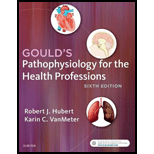
To explain: The movement of water between the body compartments that results in edema.
Concept introduction: The abnormal accumulation of fluid in the tissues of the body is known as edema. Edema usually occurs in the lungs, legs, and other skin dependent areas. The edema is caused mainly due to the osmolarity shift between the compartments. It leads to enlargement or swelling of tissues due to fluid accumulation.
Explanation of Solution
The adult body is made up of 60% of water and is present in the fluid compartments. The body fluids are distributed between the following compartments:
- Intracellular compartments (ICF)
- Extracellular compartments (ECF). ECF is again subdivided into:
- Cerebrospinal fluid (CSF)
- Interstitial fluid (ISF)
- Intravascular fluid (IVF)
In order to maintain the homeostasis of water, there always exists an equilibrium between water that is consumed and water that is excreted from the body. The concentration of water in the body is maintained within the threshold level by the following methods:
- Thirst mechanism initiated by the hypothalamus and osmoreceptor cells
- Antidiuretic hormone regulates the elimination of water through the urine
- Aldosterone regulates the reabsorption of water in the kidneys
- Natriuretic peptide hormones eliminate water and sodium through urine to avoid the occurrence of hypertension induced by high salt concentration in the blood plasma
Edema occurs if any of these mechanisms fail and the equilibrium to maintain the water concentration in the body is lost. Edema mostly occurs due to the fluid accumulation (mostly water) in the interstitial compartment of the ECF space.
The following are the ways in which the movement of water is restricted that results in edema:
- 1. Increased capillary hydrostatic pressure.
The mechanical force where the water pushes against the cell membrane is known as hydrostatic pressure. In the blood capillaries, hydrostatic pressure increases. The common causes of increased pressure include obstruction of the venous vessels, retention of salt and water in the cells, and heart failure. Due to water accumulation, the movement of fluid in the tissues increases and this in turn causes edema.
Capillary hydrostatic pressure governs the movement of water outward from the capillary into the interstitial space. When the capillary hydrostatic pressure increases, the movement (return) of fluid from the interstitial compartment to the venous terminal of the capillary is inhibited. Thus, water accumulates in the interstitial compartment and leads to pulmonary edema. In pulmonary edema, water accumulates in the alveoli leading to respiratory distress.
- 2. Loss of plasma proteins
The circulatory system is the transport medium for several molecules particularly the hormones. Several hormones are involved in water homeostasis. Plasma proteins are required to be in their optimal concentration in order to maintain the blood vessels and facilitate nutrients, molecules, and fluid exchange between the capillaries and cells. When protein levels of the plasma drops, sodium is retained in the capillaries. If sodium is retained in the capillaries, water enters the capillaries by osmotic pressure. Thus, accumulation of water in the interstitial space occurs.
- 3. Obstruction to lymphatic circulation
If the lymphatic system is affected due to an infection or a tumor, the movement of fluid in the lymphatic system is obstructed and leads to fluid accumulation. This causes localized edema.
- 4. Increased capillary permeability
Increased capillary permeability causes localized edema. Due to an immune response for an infection, chemical immune mediators are released. They increase the permeability of capillaries. When the permeability of capillaries increases, the fluid accumulates in the interstitial space that leads to local edema.
Want to see more full solutions like this?
Chapter 2 Solutions
Gould's Pathophysiology for the Health Professions, 6e
 Phlebotomy EssentialsNursingISBN:9781451194524Author:Ruth McCall, Cathee M. Tankersley MT(ASCP)Publisher:JONES+BARTLETT PUBLISHERS, INC.
Phlebotomy EssentialsNursingISBN:9781451194524Author:Ruth McCall, Cathee M. Tankersley MT(ASCP)Publisher:JONES+BARTLETT PUBLISHERS, INC. Gould's Pathophysiology for the Health Profession...NursingISBN:9780323414425Author:Robert J Hubert BSPublisher:Saunders
Gould's Pathophysiology for the Health Profession...NursingISBN:9780323414425Author:Robert J Hubert BSPublisher:Saunders Fundamentals Of NursingNursingISBN:9781496362179Author:Taylor, Carol (carol R.), LYNN, Pamela (pamela Barbara), Bartlett, Jennifer L.Publisher:Wolters Kluwer,
Fundamentals Of NursingNursingISBN:9781496362179Author:Taylor, Carol (carol R.), LYNN, Pamela (pamela Barbara), Bartlett, Jennifer L.Publisher:Wolters Kluwer, Fundamentals of Nursing, 9eNursingISBN:9780323327404Author:Patricia A. Potter RN MSN PhD FAAN, Anne Griffin Perry RN EdD FAAN, Patricia Stockert RN BSN MS PhD, Amy Hall RN BSN MS PhD CNEPublisher:Elsevier Science
Fundamentals of Nursing, 9eNursingISBN:9780323327404Author:Patricia A. Potter RN MSN PhD FAAN, Anne Griffin Perry RN EdD FAAN, Patricia Stockert RN BSN MS PhD, Amy Hall RN BSN MS PhD CNEPublisher:Elsevier Science Study Guide for Gould's Pathophysiology for the H...NursingISBN:9780323414142Author:Hubert BS, Robert J; VanMeter PhD, Karin C.Publisher:Saunders
Study Guide for Gould's Pathophysiology for the H...NursingISBN:9780323414142Author:Hubert BS, Robert J; VanMeter PhD, Karin C.Publisher:Saunders Issues and Ethics in the Helping Professions (Min...NursingISBN:9781337406291Author:Gerald Corey, Marianne Schneider Corey, Cindy CoreyPublisher:Cengage Learning
Issues and Ethics in the Helping Professions (Min...NursingISBN:9781337406291Author:Gerald Corey, Marianne Schneider Corey, Cindy CoreyPublisher:Cengage Learning





